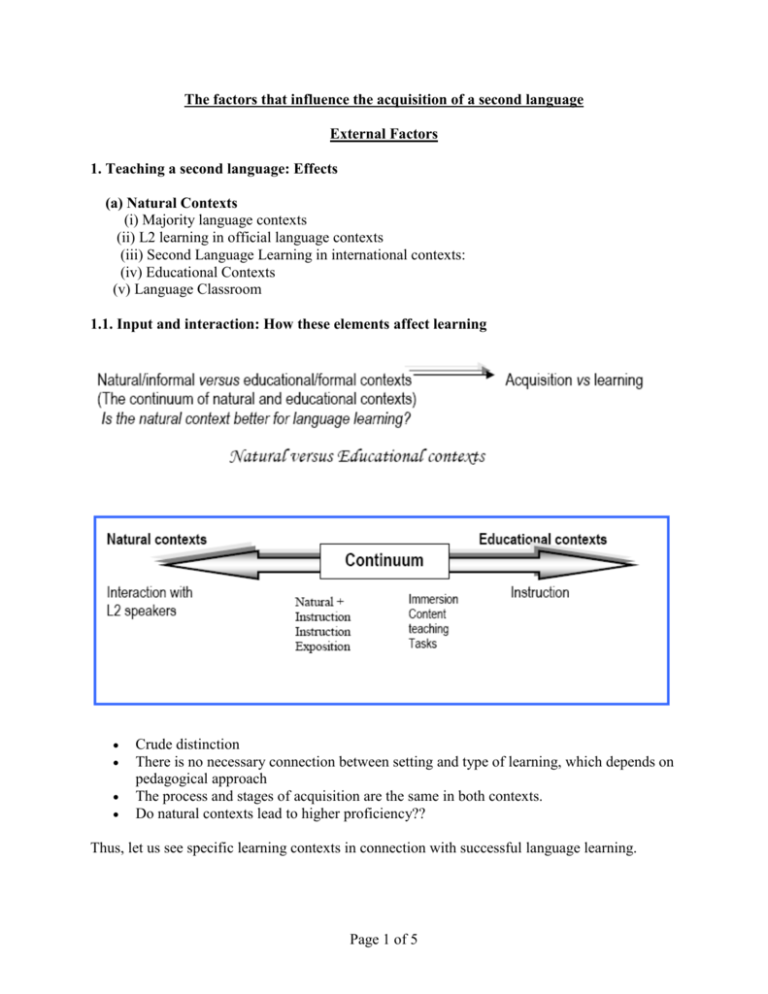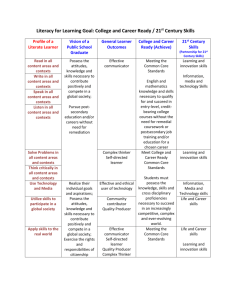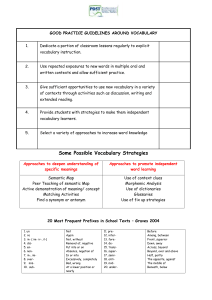Teaching a second language
advertisement

The factors that influence the acquisition of a second language External Factors 1. Teaching a second language: Effects (a) Natural Contexts (i) Majority language contexts (ii) L2 learning in official language contexts (iii) Second Language Learning in international contexts: (iv) Educational Contexts (v) Language Classroom 1.1. Input and interaction: How these elements affect learning Crude distinction There is no necessary connection between setting and type of learning, which depends on pedagogical approach The process and stages of acquisition are the same in both contexts. Do natural contexts lead to higher proficiency?? Thus, let us see specific learning contexts in connection with successful language learning. Page 1 of 5 A. Natural Contexts (in general, more fluent but also more grammatical mistakes) (If learners receive formal instruction, acquisition speed is improved, though it depends on type of instruction) A. 1. Majority language contexts: Competence determined by length of stay, but beyond 2 years it is overridden by other factors (contact leisure time, age of arrival, professional training….) Subtractive bilingualism Additive bilingualism (Minorities reach higher level of proficiency in majority contexts than majorities reach in the language of the minority) A.2. L2 learning in official language contexts (i.e. Latin in the middle ages, English in India) Social and economic advancement depends on learning language, so big instrumental motivation. Nevertheless, many learners reach up to a point, only, not native-like proficiency. If perceived as a replacement of any native language, lot of resistance (India) If perceived as ‘additional language’, or common language to communicate within multilingual communities, no resistance (not associated with any indigenous group, i.e. Zambia, Nigeria) Existence of official language: threatens those in rural areas who do not speak it, it isolates nonspeakers, it threatens cultural values of original people. It also fosters development of new standard L2 varieties (i.e. South African English) A.3. Second Language Learning in international contexts: It involves functional simplification (and not formal simplification, as IL) Used to perform only a restricted set of functions, a limited set of formulas and a limited lexicon. I.e. Airspeak, Seaspeak. GLA Factors affecting SLA success Page 2 of 5 B. Educational Contexts B.1. Segregation B.2. Mother tongue maintenance B.3. Submersion B.4. Immersion B.5. Foreign Language Classrooms B.1. Immigrant workers educated in special schools or units specially designed to cater for their language needs. Poor results (limited proficiency), But sometimes beneficial effects (i.e. short-term programmes for refugee populations). Help them adjust socially, affectively, and linguistically. Also good as all have same level (possible to tailor input) and facilitates ‘survival skills’ in the L2 B.2. Two forms: Weaker form: pupils given class in their mother tongue, directed at developing formal language skills (full literacy) Stronger form: pupils educated through the medium of their mother tongue. Results: positive ones: it leads to additive bilingualism. Considerable educational success. Linguistic, perceptual and intellectual advantages. Support of importance of L1 academic skills as a basis for successful development of L2 CALP. (L1 proficiency also benefits L2 proficiency). B.3. Linguistic minority children with a low status mother tongue are forced to accept instruction through the medium of a foreign majority language with high status. (Usually in United States and England). Results: Low academic performance. Painful experience for children. Do not facilitate success in L2 (unless L1 literacy skills are also promoted and the teacher is bilingual) B.4. (i.e. Alto Castillo). Total immersion better results than partial immersion. Early immersion better than late. Results: a pidgin can emerge. In general very effective, as ethnic identity is not threatened, input is tailored to learners’ level. B.5. Language Classroom (If combined with stays in foreign country, learning speed is increased, communicative aspects improved and more fluency) (More benefits if going abroad –according to research studies- if low proficiency level) Page 3 of 5 Teachability hypothesis (Pienemann): instruction can speed up learning process only if learner is ready for acquiring that particular element being taught, but it cannot change sequences. Influences on success in classroom teaching: Teacher! High proficency level, high knowledge of methodological issues, materials and new technologies. Highly motivated (?), good communicator, abilities to be a group leader, empathy, be accepted by group and be congruent. Socio-Economic group and family (its attitudes and values) Literacy level Summary of research studies: 1. A focus on form approach may facilitate acquisition 2. if a focus on form approach is adopted, this is more likely to succeed if: -rules are presented explicitly and supported by examples -the instruction is aimed at developing explicit knowledge through consciousness raising activities -the instruction is directed at enabling learners to establish form-meaning connections during comprehension -the instruction provides students opportunities to produce the target structure in similar circumstances to those that prevail in normal communication (focus-on-form teaching: task based syllabus with a focus on specific linguistic properties in the course of carrying out communicative activities). 3. The instructional method must be matched to individual learners’ preferred approach to learning Conclusions: Benefits of formal instruction Formal instruction results in increased accuracy and accelerates progress through developmental sequences. Its effects are, in some cases, durable. F.I. should be seen as facilitating natural language development rather than offering an alternative mode of learning Constraints on formal instruction Does formal instruction work? It depends on learner’s stage of development, form-function transparency, difficulty of language to be learnt, matching to learner’s preferred cognitive style… Page 4 of 5 Types of formal instruction B. 5. 1. Input and interaction: How these elements affect learning. ⎨ Input and L2 acquisition i. Non-grammatical adjustments ii. Linguistic adjustments (see table 5.2.) iii. Conversational adjustments (see table 5.2.) Research Results A. Non-linguistic input // comprehension and acquisition (See results on pair-work NNS-NS and NNS-NNS) B. Linguistic input // comprehension C. Linguistic input // acquisition D. Interactionally modified input // comprehension E. Interactionally modified input // acquisition Questions to reflect • What are the methodological implications of these results for becoming an effective teacher? • What is the relative importance of input in connection with learning? • Do students learn what they are taught? --------------------------------- Page 5 of 5







